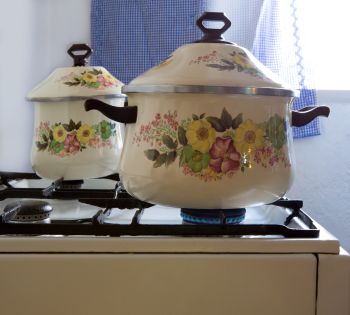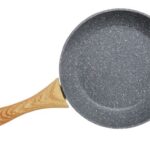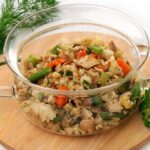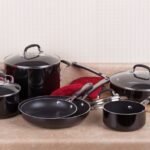The Importance of Using a Safe Cookware

Our health and well-being are greatly influenced by the quality of the food we eat, cooking techniques, and the tools we are using to make our meals. We often hear about the importance of eating organically grown food, free of pesticides and other harmful chemicals. The nutritional value of food can be easily ruined if we use cookware that leaches harmful chemicals and heavy metals into it. Safe cookware is a vital part of healthy cooking and is highly important in keeping you and your family healthy.
Hidden Dangers in Cookware
A number of recent studies have revealed the presence of harmful chemicals and heavy metals in aluminum and nonstick cookware products. Cooking food in reactive cookware can add dangerous toxins to your food. New research suggests that certain harmful chemicals in cookware may contribute to various health problems. Some chemicals also may pollute the environment and pose health risks during the manufacturing process.
Choosing Safe Cookware
When picking up new cookware, consumers often underestimate the potential negative health effects. There are some types of cookware available on the market, which may pose health risks if used regularly. To protect your body from exposure to harmful toxins, take safety into consideration when investing in a new cookware set.
The Safest Materials for Producing Cookware
Glass cookware is quite safe and nonreactive, meaning it will not leach harmful ingredients into your food. Being inert is a great benefit that cookware can offer, especially for cooking high-acidic and volatile foods. However, glass is heavy, prone to breaking, and does not tolerate dramatic changes in temperature. Glass is most often used to make casserole pans and baking dishes.
Ceramic
Ceramic cookware can be either clay-based or have a metal body covered by a ceramic-based coating. Clay-based ceramic cookware is safe for cooking except when coated with a glaze that contains lead. The chemical composition of ceramic is similar to sand and clay. When degrades, it will not have any adverse effects on health. Ceramic cookware purchased from a reputable store should be safe since the substances in the glaze are regulated by governments. Once ceramic cookware gets chips, cracks, or scratches on the surface, it should not be used for cooking or serving food.
Ceramic Coating
Ceramic non-stick cookware is claimed not to release toxins into the food you serve. Ceramic coating pans are a safer alternative to conventional, potentially toxic non-stick pans. The nonstick surface of ceramic-coated pans doesn’t release harmful fumes when the pan is heated. The non-stick coating is also resistant to flaking.
Enamel
Enamel cookware uses an enamel coating over a durable material like steel and cast iron. Enameled cast iron cookware is one of the safest types of cookware. The high-quality enamel coating is non-reactive and is safe for all types of cooking. As long as the enamel is not scratched or chipped the cooking surface prevents metals from leaking into food. A low-quality enamel may contain lead or may chip, allowing materials under the coating to leach into food. Enamel cookware should not be used once the finish has been damaged. Although enamel finishes are generally nonreactive, they can discolor. The main drawbacks of enamel-coated cast iron are that it is expensive and requires hand washing. Le Creuset and Staub are known for their high-quality enamel-coated cast iron pans.
Clay
Clay is inert, safe, and natural material. Clay cookware holds nutrient content intact and keeps food moist and delicious. However, clay cookware is less durable than some other cookware and needs extra care to prolong its lifespan.
Silicone
Silicone is a very safe polymer made from sand and oxygen. It is non-reactive at temperatures of less than 428 degrees. Silicone is FDA approved and according to Canada’s health agency, does not react with food or beverages, or produce any harmful fumes. Cookware made from food-grade silicone is both, heat and frost-resistant. Silicone is, also, nonstick, stain-resistant, cools quickly, and tolerates high-temperature extremes. The main use of silicone cookware is for baking pans, baking mats, muffin tins, and molds.
Titanium
Titanium cookware has been proven to be safe and does not pose any risk to human health. Titanium cookware is non-reactive, non-stick, nonporous, and scratch-resistant. Titanium is extraordinarily light and extremely strong. Since titanium is a very poor heat conductor, titanium cookware uses an aluminum base for optimum heat distribution. Being non-porous, the titanium layer prevents aluminum from leaking into the food. The main drawback is that Titanium cookware is very expensive.
Cast Iron
Cast iron is durable, naturally non-stick, and less expensive than enameled cookware. But iron is continually leached into the food. With regular use, iron can reach high levels in the body and some individuals may be at risk of iron overload. People with iron overload should not use iron skillets, especially for cooking liquid and acidic foods.
Stainless Steel
Stainless steel is an alloy of iron, consisting of iron and chromium. Stainless steel cooking surface still allows other metals to leach into the foods. The elements used in stainless steel cookware that may produce negative health effects are nickel, iron, and chromium. But the combination of metals used to create stainless steel cookware is more stable and less prone to leaching than most other metals. An exception is stainless steel cookware that has been damaged by harsh scouring with a rough or abrasive material. Exposure to acidic conditions at boiling temperature, causes iron, nickel, and chromium corrosion. You should not allow acidic or salty foods to remain in stainless steel cookware for long periods.
Other Materials for Producing Cookware
Teflon
Teflon is a brand name for products made from Polytetrafluoroethylene (PTFE). Another chemical used in the process of making Teflon is Perfluorooctanoic acid (PFOA). The major health effect linked with Teflon is the possible release of dangerous fumes into the air from a pan that is overheated. These toxic fumes can cause flu-like symptoms in humans (Polymer fume fever) and have been shown to be deadly to birds. Scientific studies have suggested that high levels of PFOA in human blood could be linked to high cholesterol levels, reduced fertility, and thyroid disease. Manufacturers agreed to eliminate PFOA emissions by the year 2015. You should throw out your Teflon cookware immediately.
Aluminum
Aluminum cookware is one of the most common types of cookware. It is lightweight, an excellent heat conductor, and is fairly inexpensive. Raw aluminum is highly reactive to leafy vegetables and acidic foods and is prone to warping and scratching. Aluminum cookware can contaminate food with aluminum during cooking. High levels of aluminum in the body may cause respiratory and neurological problems. Aluminum ingestion is also associated with Alzheimer’s disease. Research suggests that the human nervous system may be a target of aluminum toxicity. Since aluminum cookware may pose some health hazards, it is a good idea to avoid aluminum cookware for cooking.
Anodized Aluminum
Anodized aluminum cookware has a durable, non-stick, and scratch-resistant surface. The anodization process is believed to reduce the leaching of aluminum from cookware into foods, but there are still some potential health concerns, depending on the quality of the non-stick coating.
Copper
Copper cookware has high thermal conductivity and even heat distribution. Copper is relatively easily dissolved by alkaline or acidic foods during cooking. Large amounts of copper can cause a variety of health problems like behavior disorders, headaches, vomiting, depression, eczema, acne, and poor immune function. While copper may be a safer choice of cookware material than Teflon or aluminum, it is not recommended for your kitchen due to leaching concerns.
Safe Non-Stick Cookware
Safe non-stick cookware is made without Perfluorooctanoic Acid (PFOA) and gives you all the great advantages of the nonstick surface, but without the potential risks to human health and the environment. This cookware includes ceramic coated, titanium-reinforced, stone coated, and diamond coated cookware.
Main Advantages of Using Healthy Non-Stick Cookware
- Safe nonstick cookware remains non-toxic, without integrating any harmful substances Into your food;
- Non-stick pots and pans offer health benefits of oil-free and low-fat cooking;
- This type of cookware is very easy to clean.
Safe Cooking Temperatures
One thing we also should avoid is high-temperature cooking. Right cooking methods can preserve nutrients while overheating can decrease the nutrient value of food, and make enzymes in food inactive. Foods cooked at high temperatures, like meats, produce compounds that can increase inflammation in the body. Cooking at higher temperatures also affects the integrity of cookware.
It is important to cook foods to the right temperature to avoid foodborne illness. Using a food thermometer is the only reliable way to determine if food is cooked properly.




why are there harmful chemicals in pots and pans.
If soapstone is so safe, why isn’t it mentioned?